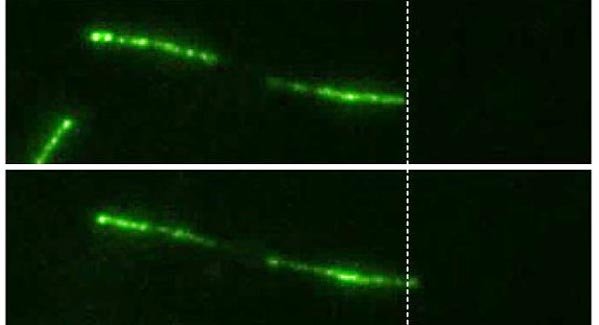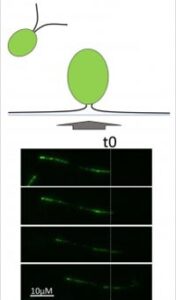Sugars influence cell-to-surface adhesion

Using TIRF microscopy, Flagella-mediated adhesion can be visualized and analysed.
© Lara Hoepfner
Biotechnologists measure the forces with which algae cells adhere to surfaces and move on them
How can cells adhere to surfaces and move on them? This is a question which was investigated by an international team of researchers headed by Prof. Michael Hippler from the University of Münster and Prof. Kaiyao Huang from the Institute of Hydrobiology (Chinese Academy of Sciences, Wuhan, China). The researchers used the green alga Chlamydomonas reinhardtii as their model organism. They manipulated the alga by altering the sugar modifications in proteins on the cell surface. As a result, they were able to alter the cellular surface adhesion, also known as adhesion force. The results have now been published in the open access scientific journal “eLife”.
Background and methodology

© Lara Hoepfner
In order to move, the green alga has two thread-like flagella on its cell surface. The alga actually uses these flagella for swimming, but it can also use them to adhere to surfaces and glide along them. The researchers now wanted to find out how movement and adhesion on the part of the alga can be manipulated. “We discovered that proteins on cell surfaces that are involved in this process are modified by certain sugars. If these sugar chains on the proteins are altered, this enables their properties to be altered,” explains Michael Hippler from the Institute of the Biology and Biotechnology of Plants at Münster University.
Experts then describe such proteins as being N-glycosylated – a modification in which carbohydrates are docked onto amino groups. Alterations to these sugar modifications by genetically manipulating the algae showed that the adhesion force of the algae and, as a result, any adhesion to surfaces were reduced. At the same time, there was no change in the cells gliding on the surface. The much-reduced force with which the mutants adhere to surfaces is therefore still sufficient, under laboratory conditions, to enable gliding to take place.
In order to study these processes, the researchers first used so-called insertional mutagenesis and the CRISPR/Cas9 method to deactivate genes which encode enzymes relevant to the N-glycosylation process. “The next step was to analyse the sugar modifications of these genetically altered algae strains using mass spectrometry methods,” says Michael Hippler, explaining the team’s approach. In order to visualise the cell-gliding, the researchers used a special method of optical microscopy – total internal reflection fluorescence microscopy (TIRF). This method is frequently used to carry out examinations of structures which are located very close to a surface. For this purpose, a fluorescent protein was expressed in the flagella of the algae in order to make the flagella and the cell-gliding visible.
In order to measure how much force was used in adhering the individual cells to the surface, atomic force microscopy was used and micropipette adhesion measurements were undertaken in collaboration with groups at the University of Liverpool (UK) and the Max Planck Institute of Dynamics and Self-Organization in Göttingen. “This enabled us to verify that adhesion forces in the nanometre range are reduced by altering the protein sugar modifications,” adds Kaiyao Huang.
The two flagella on the green alga resemble for example not only the flagella of sperm but also other movable flagella. These are usually called ‘cilia’ and are also found in the human body – for example in the respiratory tracts. “If we transfer our findings to human cells, sugar-modified proteins could be used to change the interaction of sperm or cilia with all sorts of surfaces,” say Kaiyao Huang and Michael Hippler.
Research participants
Besides researchers from the University of Münster, scientists from Berlin’s Humboldt University, the Universities of Wuhan (China) and Liverpool (England) and the Max Planck Institute of Dynamics and Self-Organization in Göttingen contributed to the study.
Funding
The study received financial support from the German Research Foundation (DFG) and the National Nature Science Foundation of China, as well as from the Royal Society and the Biotechnology and Biological Sciences Research Council in the UK.
Original publication
Nannan Xu, Anne Oltmanns, Longsheng Zhao, Antoine Girot, Marzieh Karimi, Lara Hoepfner, Simon Kelterborn, Martin Scholz, Julia Beißel, Peter Hegemann, Oliver Bäumchen, Lu-Ning Liu, Kaiyao Huang, Michael Hippler (2020). Altered N-glycan composition impacts flagella mediated adhesion in Chlamydomonas reinhardtii. eLife. DOI: 10.1101/2020.05.18.102624
Further information
https://www.uni-muenster.de/news/view.php?cmdid=11461&lang=en
All latest news from the category: Life Sciences and Chemistry
Articles and reports from the Life Sciences and chemistry area deal with applied and basic research into modern biology, chemistry and human medicine.
Valuable information can be found on a range of life sciences fields including bacteriology, biochemistry, bionics, bioinformatics, biophysics, biotechnology, genetics, geobotany, human biology, marine biology, microbiology, molecular biology, cellular biology, zoology, bioinorganic chemistry, microchemistry and environmental chemistry.
Newest articles

NASA: Mystery of life’s handedness deepens
The mystery of why life uses molecules with specific orientations has deepened with a NASA-funded discovery that RNA — a key molecule thought to have potentially held the instructions for…

What are the effects of historic lithium mining on water quality?
Study reveals low levels of common contaminants but high levels of other elements in waters associated with an abandoned lithium mine. Lithium ore and mining waste from a historic lithium…

Quantum-inspired design boosts efficiency of heat-to-electricity conversion
Rice engineers take unconventional route to improving thermophotovoltaic systems. Researchers at Rice University have found a new way to improve a key element of thermophotovoltaic (TPV) systems, which convert heat…



